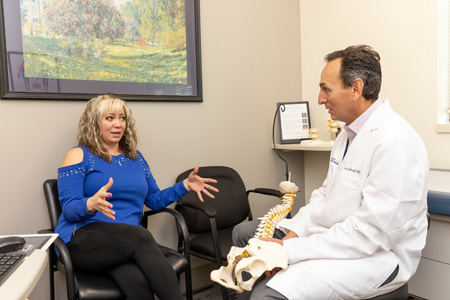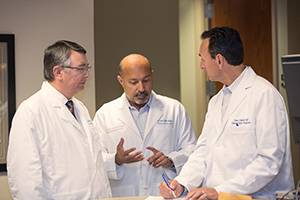Pain Prevention
Preventing back and neck pain
Once you encounter back or neck pain, you are four times as likely to experience it again. This is why prevention is essential to your long-term recovery.
One of the best ways to avoid back pain is to exercise
and stretch. Low-impact aerobics, such as walking or swimming,
are an ideal way to prevent or treat back pain. Stop if the exercise
becomes painful, and always remember to stretch. Stretching is
easy to incorporate into your daily routine. You can even do it
in front of the television.
Once you encounter back or neck pain, you are four times as likely to experience it again. This is why prevention is essential to your long-term recovery.
One of the best ways to avoid back pain is to exercise and stretch. Low-impact aerobics, such as walking or swimming, are an ideal way to prevent or treat back pain. Stop if the exercise becomes painful, and always remember to stretch. Stretching is easy to incorporate into your daily routine. You can even do it in front of the television.
Preventing back and neck pain at work
Proper multidisciplinary rehabilitation programs are structured around returning the patient to work. Once the collaborative effort has paid off and the patient is back on the job, it is important to prevent future back attacks. In just about any job situation, there are going to be hazards that need to be avoided, whether it is sitting at a desk or working in a warehouse.
Sitting at a desk
In the last decade, the word "ergonomics" seems to surface more and more in the workplace. Ergonomics is basically a fancy word for making sure the way in which you perform a task is done in the most safe and efficient way possible. Ergonomics is often applied to those sitting at a desk during the day. While the monotony of sitting at a desk all day seems harmless, sitting for long periods can actually lead to back pain. The back does not do well being in a static position for long periods of time. Sitting also places some load on the back, especially if the chair is poorly designed.
 The basic rules of desk-related ergonomics
The basic rules of desk-related ergonomics
1. Make sure your chair molds properly to your back. Many employers concerned with the safety of their workers purchase chairs that support the low back. If you are too short or too tall for your back to rest properly in these chairs, or if your company does not offer ergonomically designed chairs, consider bringing in a rolled up towel. Place it behind your low back to reduce the stress on the back.
2. Make sure your feet rest flat on the floor. If this is a problem, use a footstool. Proper foot and leg alignment will ease back stress.
3. At your desk, your forearms and thighs should be parallel while typing for proper shoulder alignment. If you need, use a pad to support your wrists while typing.
4. When you type, your neck should not have to crane constantly as your eyes dart from keyboard to monitor. To avoid this, the monitor should be at eye level or slightly below eye-level.
5. Get up and move around every half hour. Your back enjoys movement. Reward it occasionally even if its just a quick stretch by the side of your desk.
Standing for long periods

Some jobs leave you standing for long periods of time. For instance, teachers and cashiers must stand for several hours without rest. Although you probably do not spend very much time thinking about it, while standing, people rarely equally distribute their weight onto both legs. Rather, they tend to shift weight from one side to another throwing the spine out of alignment, which can lead to back strain.
If you find yourself having difficulty standing without shifting weight, try standing with one leg on a footrest, periodically switching feet. Take a minute every now and then to do back exercises, which will help loosen up stiffness.
Driving and back pain
Just like a desk job, sitting for long periods while driving can cause strain on the back. Many seats in cars are designed to support the spine properly, but even if your car was designed with ergonomics in mind, your height may differ from the typical height person the seat was designed for. Feel it out. If your back hurts after a long drive, roll up a towel and place it behind your low back to support the lumbar spine.
Long drives can cause muscle strain. Muscles are designed to move and stretch. Sitting pulls the muscles into their shortened position, causing stiffness. Also, the sciatic nerve, which runs between the spine and thighs can be compressed as a result of sitting for long periods of time. Be sure to remove your wallet from your back pocket during a long drive, as it can place pressure on the sciatic nerve. Toprevent back pain, stop and stretch every hour or so to keep muscles loose.
Lifting heavy objects
A long drive is often followed by yanking heavy suitcases out of the trunk. Watch out. Your back is at high risk of injury. Even if you have not been driving long distances, lifting a heavy object might be a normal part of your day-to-day tasks at work. Accidents are prone to occur during improper lifting. Mothers are also at risk when it comes to heavy lifting. Lifting a child can cause back strain if not done properly. To learn how to lift properly, click here.
Other ways to prevent back or neck strain:
 Avoid sitting for long periods
Avoid sitting for long periods
The spine likes movement. Anything that puts the spine in a static position creates stress, which can cause back and neck pain. Every hour, stand, walk around, bend, arch backward gently and twist. Doing so at regular intervals will lengthen the amount of time you can sit comfortably. Also, get an ergonomically-designed chair or an orthopedic insert to support your spine, especially if your job involves long periods of sitting. Or roll up a towel, and place it behind your low back.
Find comfortable way to stand
Prolonged standing can also strain the back. If you have to stand for long periods of time, prop one foot on a small stool or telephone book to reduce stress in the low back. Alternate with the other foot. Every half hour, bend over and touch your toes with your knees slightly bent, or do some of the stretching exercises shown in this Web site. They will help loosen your muscles, ligaments and joints.
Plane rides
While traveling on a plane, it helps to raise your feet on a briefcase or a bag underneath the seat in front of you. Ask for a pillow to place behind your low back to improve lumbar support. It is important to get up frequently and walk to the bathroom and back. Avoid hour-long periods in your seat.
Sleeping positions
Avoid sleeping on your stomach, which arches your back and puts pressure on your spine. Instead, lie on your back with a small pillow tucked under your knees. This position unloads the spine. An alternate position is to lie on your side with a pillow between your knees. If you like sleeping on your stomach, place a soft, flat pillow under your stomach to eliminate some of the arch that can stress your back.
Mattress considerations
It is important to sleep on a mattress with optimal back support, whether it is a conventional mattress or a waterbed. Older waterbeds were mushy and provided little support. However, now there are waterbeds that allow you to adjust the level of firmness. A good mattress should relate to your body shape. Generally, go with what feels comfortable to you.
